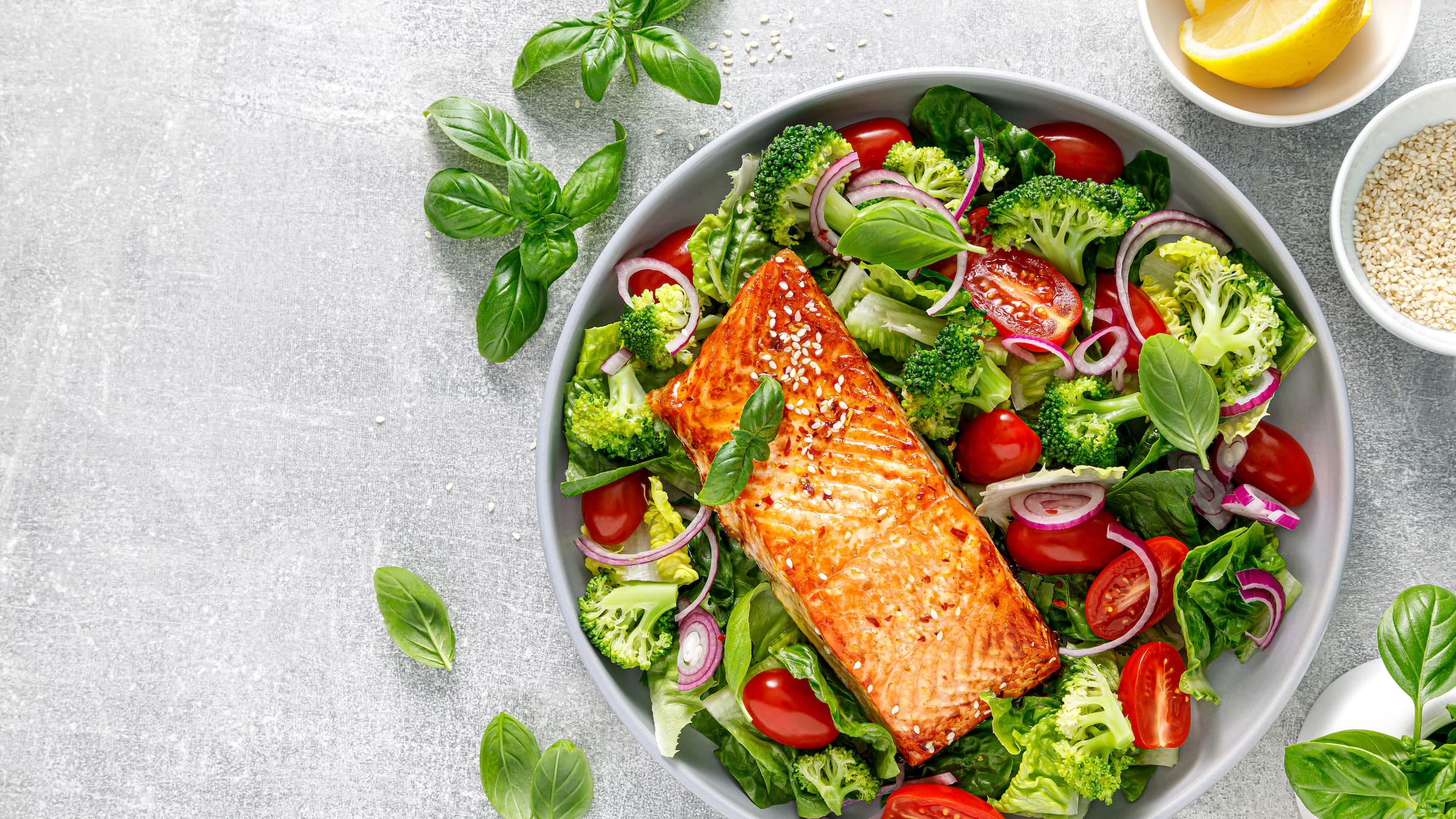- The keto diet is restrictive, but it still offers many food options.
- It’s important to eat a balanced diet on keto to maintain nutritional levels.
- Get creative with your cooking to keep your meals interesting and help you stay committed to keto.
So you’re ready to start a keto diet for weight loss. But first things first: You need a list of everything you can and can’t eat on keto.
At Noom, we don’t label any food as off limits or bad. However, we get that keto is a diet with very specific requirements, and we offer support for different eating choices.
To help you out, we’ve developed this helpful list of keto foods for beginners. Before you start eating keto and following this list, make sure you understand the risks and challenges of this low-carb diet.
Note: Consult with your health care provider before making dietary changes.
This is Chapter 2 of Noom's Guide to the Keto Diet:
- Empowering Your Wellness Journey: Exciting Updates to Noom
- The Noom Kitchen Cookbook: Healthy Living Secrets
- What is the ketogenic diet? Everything you need to know
- The ultimate keto food list
- Keto weight loss: FAQs and practical tips
- Not losing weight on keto? Here are 9 reasons why
- Vegetarian keto for beginners
- 67 easy, healthy keto recipes for weight loss
- 10 low-carb keto drinks for worry-free hydration
- Keto for women: Benefits, risks, and practical tips
What you can eat on a keto diet
The keto diet requires that you cut carbs significantly, while eating plenty of fats. You can also eat proteins, which may help you feel satisfied for longer.
Below are foods that are high in fats and proteins, but low in carbs. Keep in mind that it’s important to track carbs you consume while eating keto.
- Red meat
Most red meats are great for keto because they contain few carbs while also loading you up with protein and fat. Beef, pork, and lamb also provide your body with important nutrients, like iron and zinc.
Just watch out for red meat with added sugar, like honey-baked ham and some deli meats.
- Seafood
Fatty fish like salmon is a great keto choice because it tends to be low in carbs and high in omega-3 fats.
When it comes to shellfish, some are better for keto than others. Crab and shrimp are carb-free, while octopus, mussels, and oysters have some carbohydrates.
- Poultry
Chicken isn’t the only poultry item that’s keto friendly—duck and turkey are also great low-carb sources for protein and other vitamins.
- Meat substitutes
Tofu, tempeh, and seitan are low-carb, high-protein meat substitutes that also fit with vegetarian and vegan keto diets.
So whether you’re doing a vegan or vegetarian version of keto or want to cut back on meat, these options can help you get the protein you need.
- Cheese
Cheese is a near-perfect keto food—it’s low-carb, high in fat and a good amount of protein. And yes, this includes cream cheese, too.
Most varieties of cheese are good options, whether you prefer cheddar or goat. Full-fat cottage cheese is keto friendly and can be eaten as is or incorporated into other recipes, like keto pancakes or cheesecake.
It’s best to avoid American cheese or canned spray cheese while on keto because they have a relatively high amount of carbs per serving. (And they’re also highly processed.)
- Milk and cream
Standard cow’s milk is a keto no-no because of its high carb content, but other dairy products with high fat concentrations—like heavy or sour cream—are on the table.
Many unsweetened, plant-based milks also contain low amounts of carbs and are great for keto. Good options include unsweetened almond milk, soy milk, and coconut milk, to name a few.
Be careful, however, of grain-based versions like oat and rice milk, which have a lot of carbs per serving.
- Yogurt
With yogurts, the key is to look for high fat and low sugar.
So, plain Greek yogurt is acceptable for a keto diet, and it has a ton of protein, too. It’s delicious as is for breakfast or a snack, plus you can use it as a base to make sauces or dips. There are also baking recipes that use Greek yogurt.
By contrast, many commercial yogurts with added fruit or sugar have too many carbs for keto.
- Eggs
Eggs are another keto protein staple. One large egg contains less than one carb and more than six grams of protein.
Plus, eggs can be eaten in a variety of ways. Don’t have a plan for dinner? Make some scrambled eggs. Need a quick snack? Grab a hard-boiled egg.
- Nuts
Low-carb nuts include pecans, almonds, pistachios, walnuts, Brazil nuts, macadamias, pine nuts, peanuts, and walnuts.
These nuts are all full of healthy fats, fiber, protein, and vitamins—making them a nutritious, filling keto snack.
- Seeds
Seeds make a good snack on their own. Or, add them to a salad for a bit of crunch. You can also blend them into smoothies to make them extra creamy.
Good seed options include sunflower, chia, flax, sunflower, and hemp seeds.
- Condiments
Low-sugar condiments like mustard, hot sauce, harissa, and mayonnaise are all great keto options because they’re essentially carb-free.
Some popular condiments also have keto-friendly versions, like sugar-free ketchup and barbecue sauce.
- Vegetables
The general rule for vegetables on keto is to focus on above-ground produce, especially leafy greens. These veggies tend to be low-carb and nutrient-dense.
Examples of keto-friendly veggies include:
- Arugula
- Asparagus
- Bell peppers
- Brussels sprouts
- Cabbage
- Cauliflower
- Eggplant
- Green beans
- Kale
- Spinach
- Zucchini
- Fruits
Can you eat fruit on keto? Yes and no. You have to choose your fruits carefully because some contain too many carbs in the form of sugar to fit into a keto diet.
Strawberries and raspberries provide antioxidants and are great for keto, but high-carb berries like blueberries and blackberries might make it hard to stay within your daily goal. Even a half cup of blueberries has about 10 grams of carbs.
Avocado is technically a fruit—a berry, to be exact—and is a great keto option that you can work into an endless amount of meals.
These aren’t the only keto-friendly fruits you can eat, but because so many are high in carbs, your diet will likely be a little less fruity on keto.
- Butter
Butter and its clarified counterpart ghee, are both good fats that contain little to no carbs. Use them in your cooking to bump up the flavor of your keto dishes.
- Oils
Oils are keto-friendly and a great way to cook and keep your fat intake up on keto. You can also use them to make your own salad dressings.
Olive oil is not only keto friendly—it’s also good for your heart, thanks to its oleic acid. Other oils ideal for keto cooking include avocado, coconut, vegetable, and sesame.
- Keto-friendly snacks
Many of the best keto snacks are easy to prepare and perfect for taking on the go while safely fitting into your daily carb count.
- These one-ingredient cheese crisps can be ready in 5 minutes. Customize them with your favorite type of cheese for a crunchy treat to satisfy your snack craving.
- This recipe for candied pecans is simple and can satisfy your sweet tooth without involving sugar.
- Did you eat celery and peanut butter when you were a kid? It makes a great snack for adults, too! This snack is packed with healthy fats and nutrients while also being refreshing and delicious. You can also adapt this traditional snack by substituting almond butter, which is lower in carbs and higher in fiber than peanut butter.
- Keto sweeteners
There are a bunch of ways to sweeten a dish, drink, or snack without traditional sugar or honey (which aren’t keto friendly).
- Stevia is a natural sweetener that is very low or zero calories and does not cause blood sugar to spike.
- Monk fruit sweetener comes from a fruit found in Southeast Asia. While it’s extremely sweet, it contains no sugar or carbs.
- Sucralose—most commonly found in Splenda—doesn’t metabolize (or absorb) in the body, so it adds no carbs or calories to what you eat.
Note that some people find that non-sugar sweeteners cause side effects like upset stomach, so be sure to start slowly when adding them to your diet.
- Keto-friendly drinks
Staying hydrated is vital for all of us, regardless of diet. Keto is no exception.
- Water is always the best thing you can drink. If plain water isn’t your cup of tea, add some lemon to brighten it up. Speaking of tea, unsweetened tea and black coffee are both keto friendly. And, because they’re caffeinated, they can increase your metabolism.
- If you prefer your teas and coffees sweet and/or creamy, you can use a keto-friendly sweetener (see above) or heavy cream.
- Diet soda in moderation is fine for keto, as it contains zero carbs.
What you can’t eat on a keto diet
On the keto diet, you keep your carbohydrate intake to just 5% to 10% of your daily calories to enter ketosis.
To stay within your carb limit, there are a few foods you’ll need to cut down or cut out altogether.
- Grains
Wheat, oats, barley, rice, and cornmeal are common grains to avoid. Anything made from these ingredients is considered a grain product—including pasta, cereals, oatmeal, and most baked goods.
Keep in mind that, for keto, it doesn’t matter if something is whole grain or not. It’s still a grain product and full of carbs.
- High sugar fruits
Many popular fruits, including bananas and grapes, have too many carbs for a ketogenic diet and can cause your blood sugar to spike.
Other fruits high in sugar include pomegranates, mangos, oranges, pears, apples, peaches, and kiwi.
- Desserts with sugar
To maintain a healthy diet, it’s best to eat sugar in moderation. On the keto diet, sugar is especially tricky as it can cause your blood sugar levels to rise and will throw off your ketosis goals.
To stay in ketosis, you’ll want to find keto-friendly versions of your favorite desserts. For example, almond flour cookies cookies, grain-free cereals, and low-carb or sugar-free candy (see our baking section below for more details).
- Starchy veggies
While many vegetables are keto-friendly, there are some that are high in carbs.
These include peas, beets, sweet corn, and parsnips. Even carrots are on the high-end of vegetables that are starchy and high in carbs.
This also means no potatoes. Even though potatoes are full of nutrients like potassium and vitamin C, they have way too many carbs for keto. All types of potatoes—russet, sweet, Yukon… you name it—are off limits.
- Sugary condiments and sauces
Traditional condiments like ketchup and salad dressing are often full of added sugars, which can take you out of ketosis.
To maintain this low-carb diet, look for keto-friendly versions of your favorite sauces and condiments. You can find these products in most grocery stores.
- High-carb and/or sugary milks
Cow’s milk and oat milk have a high-carb content that can throw off your ketosis goals.
Just one cup of cow’s milk has 12 grams of carbs in it. Oat milk tells you right in its name that it’s probably not keto friendly, as oats are a grain.
To stay in ketosis, you’ll also want to drink limited amounts of sweetened milks—whether they’re keto or plant-based.
- Soda
While diet soda is typically regarded as keto-friendly, all “regular” sodas are not due to their sugar content.
One 12-ounce can of soda has nearly 40 grams of carbs, putting you at or above your daily carb intake goal.
- Alcohol
Most alcohol that people drink in social settings, whether beer or sweetened cocktails, are too high in carbs for a keto diet.
Unless you’re drinking straight-up alcohol like vodka, rum, whiskey, or tequila (which are carb-free on their own), it’s best to avoid alcohol.
- Legumes
Beans, chickpeas, and similar foods are full of nutrients—like fiber, protein, and calcium—but they’re also high in carbs. If you do include them in your keto diet, do it sparingly.
Two varieties of legumes—peanuts and soybeans—are lower in carbs and okay for keto in moderation.
- Sweeteners
Traditional sweeteners—like white and brown sugar, honey, and maple syrup—are too high in carbs for keto.
- Fruit juices
Many fruit juices may look harmless, but they’re often loaded with sugar and don’t align with keto goals.
Outside of adding lemon or lime juice to water for some added brightness and flavor, it’s best to avoid fruit juices while on keto.
Baking on keto
If you enjoy baking, there are plenty of keto-friendly recipes out there to satisfy your sweet tooth. Many keto-friendly treats rely on two non-grain flours:
- Coconut flour: It’s high in fiber and (of course) has a strong coconut flavor to elevate your baked goods. Keep in mind that coconut flour is a bit more dry than all-purpose flour, so you may need to add extra moisture to your dessert recipe if you’re using it as a substitute.
- Almond flour is full of nutrients like protein, fiber, magnesium, and vitamin E, a powerful antioxidant. Its light, delicate flavor is perfect for muffins, cakes, and even cookies.
The downside? Some of these products can be expensive. If you’re on a tight budget, consider blending your own almonds and coconut pulp to create these flours.
Remember, you can’t always use these flours as 1:1 replacements. Be sure to check how you might need to adjust your flour amounts, depending on what you’re baking.
Where to find recipes for keto diet foods
Eating the same foods day in and day out can be boring, and make you give up on your eating goals.
Thankfully, there are plenty of online resources for keto recipes to help you prepare a variety of delicious meals that are also keto friendly.
- Noom Weight has an extensive recipe database, including this article with 67 keto recipes.
- You can also get a week of meals and snacks (recipes included, of course) that break up the monotony of a typical keto diet but still keep you within carb limits.
Losing weight on the keto diet with Noom
The keto diet is a big commitment, to be sure. Noom can help you stick with your goals and maintain a healthy lifestyle.
Our program isn’t keto-specific, but many of our features—like food tracking, daily lessons, and coaching—are helpful for staying on track.
Ultimately, Noom Weight can help make your experience with the keto diet more successful and sustainable by helping you understand the psychological side of eating—as well as nutritional principles that apply to food.



